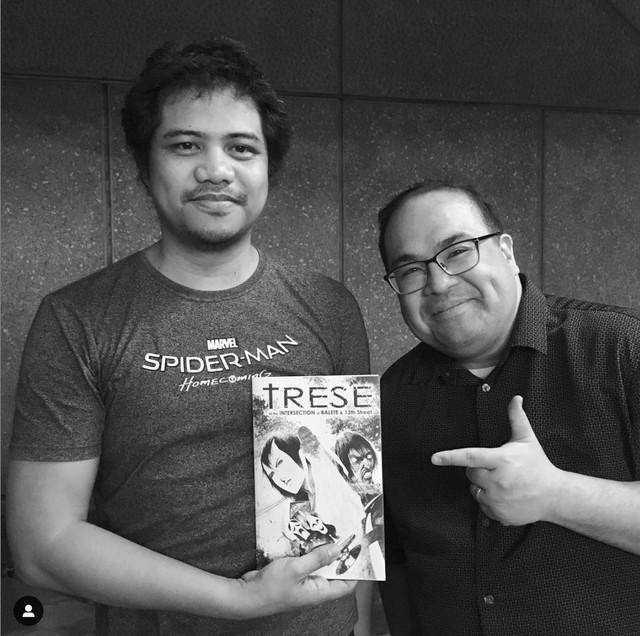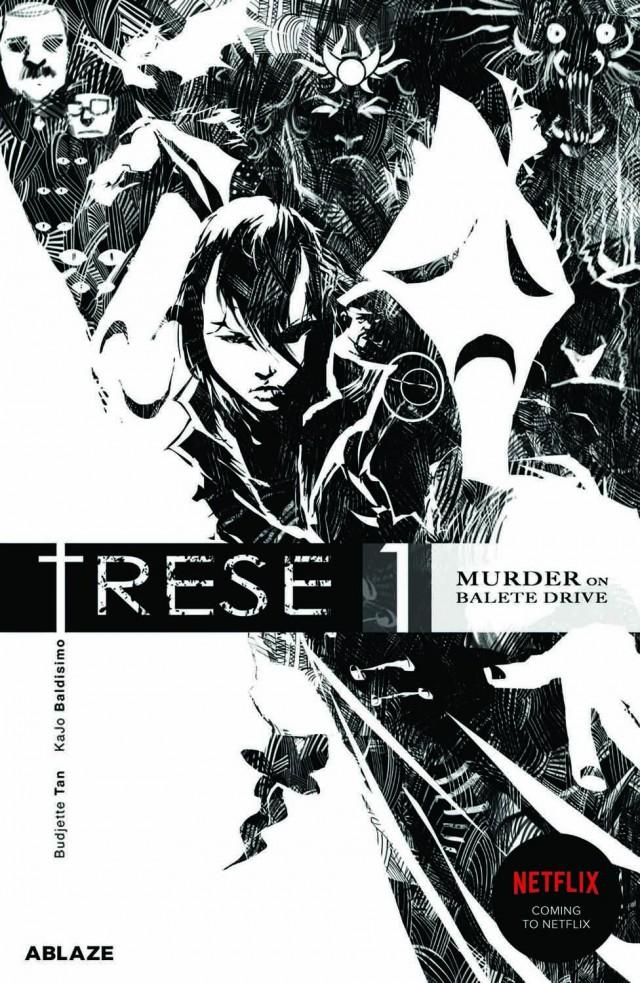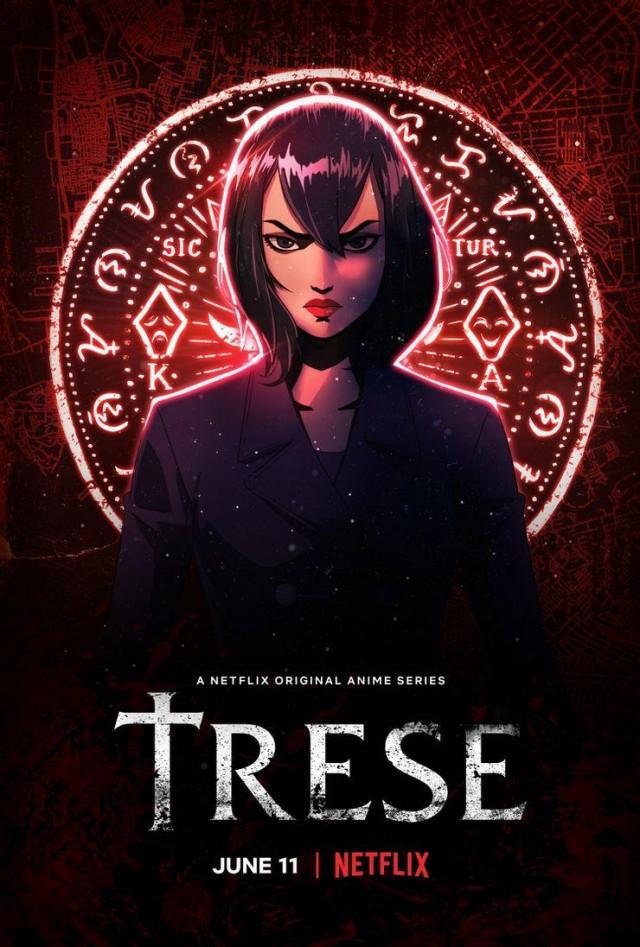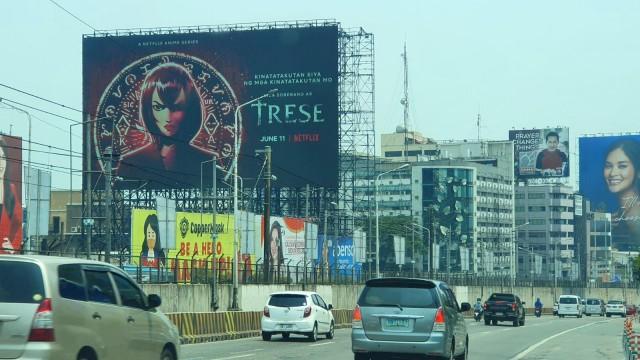How 'Trese' conquered Philippine pop culture
The hype on "Trese," the first Philippine anime series on Netflix, is real.
Based on the award-winning comic book of the same name by writer Budjette “Budj” Tan and artist Kajo Baldisimo, "Trese" isn't just arriving on Netflix full throttle, it's taking on global pop culture, as well.
Enormous multimedia billboards proclaim the series’ pending arrival, while teasers, trailers, and preview images stoke audience anticipation online. It even has an official “Trese” emoji whenever someone uses #TabiTabiPo or #TreseOnNetflix, the streaming giant giving it a marketing push befitting a major Hollywood blockbuster.
“It hasn’t sunk in yet!” laughs Kajo when asked about his reaction to the hype. “When the show premieres on the 11th, and we get to watch it with everybody else, then it becomes real.”
Speaking with GMA News Online from his home in Davao, Baldisimo’s enthusiasm is obvious, and it’s hard to blame him; it’s not every day that one’s side-hustle becomes gets picked up by a major streaming platform to become a full-fledged animated series dubbed in half a dozen languages.
It all began with a text.

In the early 2000s, Kajo and Budj were young advertising creatives, learning the hard way that rejection was part of the job description with inordinate amounts of time and effort spent on ideas, concepts, and plans that could be approved or discarded at the drop of a hat.
It was respectable work, and it paid the bills, but it was a far cry from the comic book-creating dreams the two had fostered in their school days.
With an eye towards preserving his sanity, Kajo messaged Budjette (then working at an ad agency a few streets away), asking him for something to draw. He didn’t care what it was, as long as it was something they could own, and as far away as possible from their daily grind.
Budjette was keen on the idea, but admitted that he didn’t have anything off the top of his head, so he promised Kajo that he’d look through his files and see if he could come up with anything.
“We just wanted to do something other than advertising!” laughs Budjette, speaking with GMA News Online from Denmark, where he serves as Creative Director for Lego’s in-house ad agency since 2016.
“No one needs to approve this, no creative director, and certainly no client - it's just you and me. I would write something, he would draw it, and we’d just release it.”
Going through his files, Budjette resurrected an old idea he’d had of a paranormal detective. Reworking the idea with Kajo the character would become Alexandra Trese, a gifted investigator tasked with keeping the peace between mortals and creatures from Philippine folklore.
Clad in a long Chinese coat and armed with an enchanted kris (dagger), Trese’s silhouette is instantly recognizable. Working with the police and accompanied by her bodyguards -the impeccably besuited twins known as the Kambal, who dash into battle with theater-inspired masks- Trese is always ready to dish out supernatural justice.
“Reflecting on it now, there's just so many counterintuitive decisions,” chuckles Budjette. “Like, ‘Let's give her a trench coat! And let's make the Kambal wear business suits in our wonderful (tropical) weather!’ Which is why I tell people the series takes place in an alternate Manila where it's always raining and cold.”
With their concept nailed down, Kajo made the commitment to, no matter how busy he got with advertising, draw and ink one page a day from Budjette’s scripts until they could complete at least one story. "I’m an introvert by nature, so I didn’t mind drawing through my lunch breaks – I would eat at my desk!” Kajo said.
Where the majority of local comics drew inspiration from American superheroes or Japanese manga and anime of the time, Kajo was influenced by the works of komiks legends like Francicso Coching and Nestor Rodondo, as well as “X-Men” artist Jim Lee.
Ultimately, the “Trese” comics would be characterized by their stark, striking imagery, owing more to police procedurals and film noir than anything else, resembling nothing so much as the unholy union of “Kolchak: The Night Stalker” and Frank Miller’s “Sin City.”
In those days, self-publishing meant going to a nearby printshop and having Kajo’s artwork photocopied and stapled into booklets that Budjette would distribute to local comic book stores on weekends. “He had to make the deliveries because he was the one with a car!” laughs Kajo.
It wasn’t long before the book found its audience and word of mouth spread: while readers were enthralled by the organic incorporation of local supernatural elements, the renderings of a city that was recognizably Manila gave the series added resonance. Budjette and Kajo soon found themselves inundated with requests for more copies and, more significantly, more stories.
Kajo and Budjette pushed on, replenishing the comic shops and creating more stories to feed their growing fanbase. Determined not to rest on their laurels, they worked doubly hard to up the ante: Budjette evolved the narrative, peppering ostensibly standalone stories with increasingly-layered bits of continuity, while Kajo worked tirelessly to improve his visual storytelling techniques.
By the time they’d put together enough material for a publisher to compile (in the book now known as “Trese Volume 1: “Murder on Balete Drive”), they were attracting mainstream attention.

With social media in its infancy in 2005, “Trese” became one of the first local fandoms to have an online presence, with Budjette establishing a blog to serve as the comic’s de facto website.
There, he could post updates on upcoming stories and interact with fans. When Facebook eventually came along, an official fan group was set up, where fans now regularly post memes, share news, and, to this day, geek out about all things “Trese."
“Trese Volume 2: Unreported Murders” would earn the duo their first award nomination, with a National Book Award nod for Best Graphic Literature. It didn’t win, but, as Kajo reminded Budjette, “We’re doing this for fun. We’re lucky to get the chance to tell the story that we want.”
Award recognition would come soon enough as Volumes 3, 4, and 5 would go on to win the award that Volume 2 missed out on, while the series received multiple overall nominations for Filipino Reader’s Choice Awards, and another National Book Award nomination for Volume 6.
Within the series’ first five years, attempts had been made to adapt “Trese” for the small screen or large, but plans wouldn't push through.
Still, the creators had no regrets. After all, “Trese” had enabled them to indulge their creative impulses in a way neither could have imagined, with Alexandra herself appearing in spinoff comics, prose stories, a postcard book, a video game, action figures, and even a one-man art exhibit by Kajo in 2013.
In 2018, an Indiegogo effort pushed through to get an international edition of “Trese” published, complete with updated art by Kajo, and boosted in no small part by the endorsement of New York Time Bestselling Author Neil Gaiman (“Sandman”, “Good Omens”), himself an acknowledged fan of the series.
“It’s sort of overwhelming,” says Kajo. "But if we can entertain everybody who picks up one of our books, just keep them entertained for the twenty minutes that it takes to read it, that will be enough for me.”

In November 2018, however, the unthinkable happened. After years of false starts across different formats, media, and platforms, it was announced that “Trese” would be adapted into a full-fledged animated series by streaming giant Netflix.
Produced by longtime “Trese” advocate Tanya Yuson (Hannah Montana: The Movie) and Shanty Harmaym of Indonesia’s BASE Entertainment, and directed by Filipino American Jay Oliva, an animation veteran with experience on everything from “Extreme Ghostbusters” and DC animated movies, (including “The Flashpoint Paradox”, and “Batman: Under the Red Hood”), to handling storyboards on Zack Snyder’s “Man of Steel” and “Batman V Superman,” the series’ credentials were impeccable.
As if the behind-the-scenes talent wasn’t enough, the names announced for the voice casts earlier this year set off a whole new torrent of online buzz. Liza Soberano dubbed Alexandra in the Filipino, Filipina-Canadian Shay Mitchell took on the English version. Supporting cast include the likes of Jon Jon Briones (“Miss Saigon”), Dante Basco (“Hook”, Avatar: The Last Airbender”), singer Nicole Scherzinger, and Manny Jacinto (“The Good Place”) — a clear effort towards proper Filipino representation was made.
When the first trailer dropped and went viral, the message was clear: “Trese” had made her pop culture mark, and she was playing for keeps. Netflix followed that up with billboards, social media efforts, an online countdown event for the premiere, a virtual concert with UDD, and a post-show special called “Trese: After Dark.”

Fifteen years after Kajo’s fateful text to Budjette, “Trese’s” literary adventures are far from done: seven volumes of books have been released so far, with six more scheduled for completion in the next five years.
The jury still out on a possible second season, but on top of all Trese has achieved, nobody is more amazed at its success than the two men who started the ball rolling in the first place.
“We were just making it up as we went along!” says Budjette. “When I wrote that Alexandra was the sixth child of a sixth child, we didn’t know what that meant!”
For many watching the upcoming series, it will likely be their first exposure to the spooky, strange, and downright weird things that go bump in the Philippine night. Thankfully, Alexandra will be there to keep everyone safe, and, if the show is as faithful to the books as its creators are claiming, then audiences everywhere are in for one hell of a good time. — LA, GMA News
Trese premieres on Netflix on June 11, at 12am.




